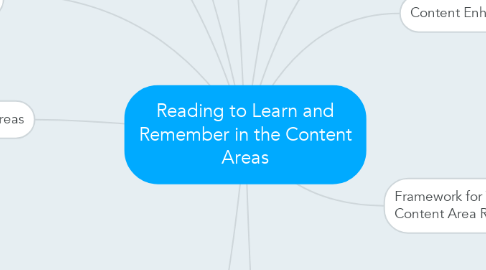
1. Instructional Techniques for Fostering learning from Text
1.1. Before-Reading Techniques
1.1.1. Anticipation Guide
1.1.2. Frazer Model of Conceptual Development
1.2. During Reading Techniques
1.2.1. Frame Questions
1.2.2. Frame Matrix
1.2.3. Study Guides
1.2.3.1. Content Guides
1.2.3.2. Pattern Guides
1.2.3.3. Glossing
1.2.4. Using WIRC Thinksheets
1.3. After Reading Techniques
1.3.1. Reflection
1.3.2. Graphic Organizer
1.3.3. Extending and Applying
1.4. KWL Plus
1.4.1. Group Brainstorming
1.4.2. Individual Brainstorming
1.4.3. Categorizing
1.4.4. Anticipating
1.4.5. Questioning
1.4.6. Reading
1.4.7. After Reading
2. Outstanding Collaborative Approaches
2.1. ReQuest
2.2. Reciprocal Teaching
2.3. Questioning the Author
3. Textbooks in the Content Areas
3.1. Adapted Texts
3.2. Directed Listening-Thinking Activity
3.3. Hands On Inquiry
4. Teaching Literature
4.1. Personal Response
4.2. Self-Selection
4.3. Sheltered English
5. Reading to Learn and Remember
5.1. Knowing Oneself as a Learner
5.2. Setting Goals
5.3. Assessing Tasks
5.4. Applying Thinking Processes and Strategies
6. Aids To Studying
6.1. Principles
6.2. Organization
6.2.1. Organizational Study Strategies
6.3. Association
6.3.1. Association Strategies
6.3.2. Acronyms
6.3.3. Rhymes
6.3.4. Acrostics
7. Content Enhancement
8. Framework for Teaching Content Area Reading
8.1. Establishing Key Ideas
8.2. Preparing for Reading
8.2.1. Activate Schema
8.2.2. Expand Vocabulary
8.2.3. Build Reasoning Skills
8.2.4. Establish Purpose/Motivate Students
8.3. Guiding the Reading
8.4. Discussing the Reading
8.5. Rereading
8.6. Extending and Applying
9. Text Structure
9.1. Narrative
9.1.1. Developing a Sense of Story
9.2. Expository
9.2.1. Time Sequence
9.2.2. Enumeration/Description
9.2.3. Compare/Contrast
9.2.4. Explanation/Process
9.2.5. Problem/Solution
9.2.6. Cause/Effect
9.3. Teaching Text Patterns
9.3.1. Using a Structural Organizer
9.3.2. Using Headings and Subheads
10. Study Habits
10.1. Metacognitive Aspects of Studying
10.2. Overcoming Obstacles to Studying
10.2.1. Lack of Discipline
10.2.2. Lack of Time
10.2.3. Boredom
10.2.4. Lack of Perseverance
10.2.5. Distractability
